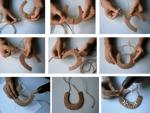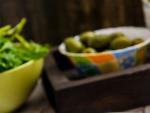What is the difference between cedar and pine. Cedar house How to distinguish cedar from pine when planting
Currently on the market finishing materials There are many types of lining available. Paneling made from pine and cedar of various varieties has become widespread. In this article we will look at some of the features of lining made from Altai cedar, and also tell you how to distinguish it from materials made from other types of wood.
This lining is unique in its own way, since the Gorno-Altai cedar, from the wood of which it is made, grows exclusively in the Altai mountains; it no longer grows in any other regions of Russia or the world. Untouched nature, the special climatic and geophysical conditions in which these trees grow give the wood special and unique properties. Residents of these places believe that these trees emit positive energy, drive away evil spirits and improve human health. Scientific research confirm that Altai cedars have a whole range of distinctive features and it is not for nothing that they have been considered extraordinary and very valuable since ancient times.
According to data obtained from scientific research, Altai cedars, compared to other Siberian cedars, have almost 2 times the density and higher strength indicators. In terms of wood's resistance to rotting, it is superior not only to such a popular material as pine, but is also identical to larch, which is recognized as practically the standard for this parameter.
Now let's move on to the question of how lining made from Altai cedar differs and how not to confuse it with materials from other types of wood.
First of all, you should pay attention to the color. It should have slightly pinkish tints; by the way, after a while your cedar lining will darken a little and acquire a reddish-pink color, which will give the interior nobility and make it more sophisticated.
The second characteristic feature is an indescribable aroma, you will not confuse it with anything else, it is a fairly strong and very pleasant pine smell with unique notes inherent only to this breed.
The lining made from Canadian cedar, unlike our Altai cedar, is darker, the color is close to brown or deep red, the smell from the wood is barely perceptible. Far Eastern or Karelian cedar is slightly brown in color, just like its Canadian counterpart does not have a strong aroma, so it is difficult to confuse these species with their Altai relative if you carefully choose.
A separate question is how to distinguish the Altai cedar lining from pine? Everything is quite simple - cedar wood is much lighter, it has a smoother and more uniform texture. Despite the fact that pine also emits a noticeable pine aroma, it is not as pleasant and strong as cedar. The pine smell should be familiar to you if you have eaten pine nuts, and once you smell it, you can’t confuse it with anything else. Also, in pine wood more resins, which not only worsens appearance, but also makes this material unsuitable for finishing a steam room.
So, let's repeat the key distinctive features linings from Gorno-Altai cedar:
- color;
- texture;
- resinousness;
- smell.
Based on the above, we recommend that you take a responsible approach to the choice of finishing materials and turn your attention to cedar lining and imitation timber from Tsar-Kedr, which have a number of amazing qualities.
Cedar, pine, spruce are trees that, by definition, belong to the Pine family. However, despite their external similarity, these plants have a number of significant differences.
Places of growth
Cedars have grown in the subtropical climatic zone Mediterranean, mountainous Crimea and Himalayas. In accordance with the name of the area where the tree grows, it is usually divided into types: Lebanese, and so on. Pines have spread in temperate subtropical climate Eurasia, North America. Scientists identify about 200 varieties of pine trees. Spruces and pines are evergreen trees. Living conditions are created by different plant forms from bushes to trees with large crowns.
Features
The monoecious cedar plant reaches 50 m in height, is evergreen, and has an impressive spreading crown. The spirally arranged needles are collected in bunches. Each needle resembles a needle and is triangular in emerald-steel color.
Pine is also a monoecious plant with short or long needles. A bunch consists of two to five needles. If a tree is damaged, rosettes begin to form on it, and short needles grow from them. Their color depends on the climate and soil composition and varies from light silver to rich green.
Cedar cones are arranged singly, in candles, and have a barrel-shaped shape. The cone ripens in the second or third year of formation. Pine cones are oblong in shape and hang from the branches. Spruce also has needle-like, but shortened needles. The roots of this tree do not go deep, but are located on the surface layers; the spruce requires fertile and wet soil.
The difference between spruce and pine is that pine is light-loving, and spruce is shade-tolerant. Pollination of the first and second species occurs with the help of wind. Pine is widely used in agriculture, its wood is valuable material for carpentry and construction, it is used as fuel. This tree is a raw material for the extraction of tar, resin and turpentine.
General conclusions regarding differences
The number of varieties of pine and spruce is tens of times greater than the number of cedar species. The growing area of pine is much wider than that of cedar. The morphological characteristics and size variability of pine are also much more diverse. A cedar bundle consists of more needle-shaped needles. Pine is less capricious in its choice of soil; its long, powerful roots go deep into the ground, which means the tree can feed on moisture and nutrients located in the deep layers of the earth.
Cedar pine, cedar
-
king of the forests
Siberian pine or cedar
Clear January day. The snow sparkling under the sun blinds the eyes, and there is such silence around, as if the whole world had plunged into a heavy, uninterrupted sleep. And this dream is guarded by formidable warriors- majestic Siberian cedars. Leonid Maksimovich Leonov compared this with an epic cliff rising in the middle of the green ocean, at the sight of which “the hat itself falls off your head with respect.” amazing tree. Its scientific name- Siberian pine. Real cedars- Lebanese, Himalayan, Atlas, Cypriot- grow in North Africa, Himalayas; in the Middle East and on the island of Cyprus. These are powerful trees- with very valuable, pleasantly smelling wood, on the shortened shoots of which there are 30-40 needles. Why is Siberian pine often called cedar? Yes, for their special status, longevity, impressive size, fragrant wood: the pioneers of Siberia and North America any tree with a pleasant smelling wood was called cedar in the simplicity of the heart.
A contemporary of A. S. Pushkin, an expert on Siberian forests, naturalist and local historian V. Dmitriev, in the article “Siberian Cedar” in 1818, enthusiastically wrote: “Be proud, places beloved by the sun, be proud, Lebanese heights, of your cedars: without seeing you in my fatherland on the mature land that belongs to Russia, I don’t even dare to dignify you, but in my eyes the shady cedar of rich Siberia will not yield to you in its beauty and will replace you for me. What majesty is in the bearing of this tree, what a sacred shadow in the density of its forests!..”
Siberian pine is significantly different from Scots pine, although they are close relatives. One of the differences concerns the seeds: in Scots pine they are small, with wings, while in Siberian cedar they are the well-known nuts. Their color is brown, they are covered with a peel and a thin inner shell, under which there is a white oily core. A large cone contains more than a hundred seeds.
The second difference concerns the needles: cedar has longer needles that last longer on the tree, and there are 5 needles in one bunch, whereas Scots pine- two each. Cedar is distinguished by a more powerful cone-shaped dark green crown. And he lives one and a half to two times longer- up to 800-850 years.
The height of Siberian pine is 35-43 meters. Its trunk is brown-gray; old trees have fissured bark. The shoots are yellow-brown, covered with long red hairs. The root system is formed depending on the nature of the soil and soil.
At the end of spring, the cedar pine becomes dusty and at this time looks especially elegant: the crimson-colored male spikelets are clearly visible against the background of dark green needles in the middle and lower parts of the crown. And at the top there are female cones, oval, purple, collected in 2-7 pieces at the terminal bud of the shoot. In plantings there are sometimes trees with only male spikelets. Pollination occurs with the help of wind. In September of the following year, cones with seeds ripen, the shape of which can be ovoid, elongated-ovate, cylindrical or cone-shaped. Outside, the seeds are covered with durable scales strung on a thick rod.
Siberian cedar is winter-hardy, thanks to which it reaches far to the north. Its artificial plantings can be found in Arkhangelsk and Murmansk regions, in particular on the Solovetsky Islands, the island of Valaam.
At the same time, the Siberian giant is undemanding to the soil, successfully tolerates both excess and lack of moisture, but prefers areas with sufficient moisture, so it grows well at the sources and along river valleys.
Cedar pine plays an important role in the native complex of Siberia.
It has been established that the drainage in cedar trees is several times greater than in other forests. It is not surprising that waters filtered by cedar tracts supply Baikal with water and feed the powerful rivers of Siberia- Ob, Yenisei, Lena.
In addition, forests of Siberian pine reliably protect soils, especially mountainous ones, from erosion. Cedar tracts located on mountain slopes Southern Siberia, play a critical role in the formation of biological and climatic processes. So, they are rich in all kinds of living creatures. In the years bountiful harvests seeds, the number of sable and squirrels increases sharply. Forest inhabitants- jays, nutcrackers, squirrels, chipmunks- They got used to deftly extracting nuts from cones. And the bears, holding the pine cone with their paws, tear off the scales with their fangs, the nuts are exposed and go into the mouth without interference.
The existence of 70 species of mammals, 200 species of birds, and many species of insects is associated with cedar trees. Special mention should be made about the nutcracker bird: by feeding on the seeds of the Siberian pine and making provisions for the winter, it contributes to the spread of the cedar. According to experts, if he did not have such a reliable partner, he would hardly be able to survive to this day.
People receive great benefits from this unique, beautiful tree. The widely known cedar balsam, used in instrument making, as well as turpentine, rosin, varnishes, and camphor are made from cedar resin.
Siberian pine wood- straight-layer, light, durable, easy to process, not susceptible to rotting,- used in the production of pencils, drawing boards, musical instruments. The Germans were the first to discover the high resonant qualities of cedar wood. German trading companies that purchased cedar oil in Russia suddenly demanded that it be exported in containers made of cedar wood, and the thickness of the container boards was almost doubled. It later turned out that when the boxes of oil arrived in Germany, they were very carefully broken down and the cedar planks were sent to musical instrument factories. Thanks to this, trading companies selling cedar oil had a very significant additional income.
Cedar trees, releasing essential oil with bactericidal properties, improve the health of the air and give it a refined aroma. In dishes made of cedar wood, milk does not sour for a long time, and in chests made of cedar planks moth won't start. Residents of the Cis-Ural region have long preferred Siberian pine for finishing their homes; the significant thickness of the wood made it possible to obtain wide boards suitable for making solid doors. In many cities of Siberia and the Urals- Turinsk, Tyumen, Tobolsk, Tomsk- buildings decorated with intricate wooden lace carved from cedar planks have been preserved. And in one of the churches in Tobolsk, an iconostasis was built from cedar.
There are a lot of cedar pine needles ascorbic acid, macro- and microelements. Vitamin flour and carotene paste are made from it, used in animal husbandry. A persistent brown dye is obtained from cedar bark, tannins are extracted, and thermal insulation boards are made.
But perhaps the most significant for humans are the seeds of the cedar pine, which are tasty and nutritious. They contain 60% percent of beautiful red golden-yellow oil, which has nutritional and technical significance, up to 20 percent protein, which is similar in amino acid composition to egg protein, about 12 percent carbohydrates, a complex of vitamins, and a rich set of macro- and microelements. Cedar oil is not inferior in quality to the famous olive oil; it is used not only by cooks, but also by artists- many famous masters diluted their paints on it.
Pine nuts are healing- help with hypertension and atherosclerosis. A traditional medicine recommends using not only kernels, but also seed shells, young shoot tips, buds, pine needles, resin...
Since ancient times, since the times of Ivan the Terrible, Siberia has been the largest supplier of pine nuts to the world market. According to historians, they were sold to Persia, China, Sweden and other countries. In 1786, academician P. S. Pallas wrote: “In Switzerland they use pine nuts in pharmacies; Milk is made from them, which is prescribed for chest diseases... Because of their insightful, thin, partly balsamic oil, they are better than almond nuts, which is why they claim that they were used with benefit by Czech people...” The main suppliers of nuts were Tobolsk and Yenisei province.
The peoples of Siberia have long treated this valuable plant with great respect, considering it sacred, the guardian of goodness, truth and justice. In the Surgut region (Khanty-Mansiysk National District, Tyumen Region), when laying the foundation for a new house, residents placed a small cedar pine tree in the front corner, saying: “Here is a warm house and a shaggy cedar!” The tree remained in the house- it was considered the habitat of the brownie.
According to Evenki legends, cedar helps to live honestly and selflessly, and is a source of strength, beauty and nobility. At the birth of a son, the Evenks planted cedar pine trees near their homes, and at the birth of a daughter- birch tree The legends and fairy tales of the Nanai people of the Amur region say that only good spirits settle in the cedar pine, because it- the most generous tree. Emphasizing the importance of this plant, the Siberians used to say: “The taiga is alive with cedar.” They believed that if a child is given a handful of pine nuts every day, he will grow up to be a good young man, and no illness will overcome him.
There are many mysteries about the cedar pine: “It stands tall, it hangs curly, it’s shaggy at the edges, it’s sweet in the middle!”, “Don’t hit me, don’t break me; climb on me: I have it!”
Currently, cedar forests occupy about 40 million hectares, or about 5 percent of the territory covered by forests. This makes it possible to collect 1-1.5 million tons of pine nuts in Siberia, but only about 20 thousand tons are harvested. Foresters have identified early-ripening, large-cone, high-yielding forms of Siberian pine. To breed them, plantations are created in which cuttings taken from high-yielding plants are grafted onto young seedlings. A hectare of such plantings yields 500-600 kilograms, and in some cases 1.5-2 tons of nuts.
Cedar pine plantations are beginning to appear in the European part of the USSR. However, its closest relative grows here - the European cedar pine, listed in the Red Book of the USSR. This rare relict species found only in the Carpathians. On Far East another relative of the Siberian pine lives - Korean cedar, distinguished by larger cones and needles, stronger and thicker seed shells. Forests containing Korean pine occupy about 4 million hectares in our country. Outside the USSR, the tree grows in eastern China, Korea and Japan.
V. Artamonov , Candidate of Biological Sciences
(Science and Life No. 11, 1989)
Cedar pine, cedar - the king of forests
The use of only deciduous trees in gardening and landscape design, including in amateur gardening, significantly reduces the aesthetic perception of plantings. They take on a completely different look in combination with evergreen coniferous plants, most of which are highly decorative in all seasons. Nice background for coniferous species there are plantations of birch, silver willow or poplar, and silver maple.
When selecting an assortment of coniferous species, one should take into account their size at maturity, growth rate, and requirements for growing conditions. It is necessary to link plantings to the size of the territory. Rare species and decorative forms are planted either in large groups, or alone. In the case of group planting, they are planted asymmetrically, trying to ensure that the three plants do not end up on the same straight line.
When creating an exhibition of coniferous or mixed plantings, it is necessary to take into account that conifers take root more difficult than deciduous ones. Young plants are best replanted at 3-4 years of age, which is only possible in amateur gardening.
When transplanting conifers, you should remember that they react painfully to a change in orientation. Therefore, in the nursery, the seedlings should be marked to the south in order to plant them in the same direction. permanent place. After planting, the plants are watered abundantly, and the crowns are sprinkled in the early morning and late evening hours. In a new place, conifers take root within several years.
Cedars- amazingly beautiful trees. They occupy a special place of honor among conifers. It is no coincidence that cedar is popularly called “the king of the forests”, “the boyar in a green caftan”. As the legend says, at first cedars grew only in paradise. When God kicked the first people out of paradise for their sins, Adam hid three seeds in his palm- cedar, cypress and pine. From these seeds supposedly the forests of the earth subsequently grew.
Siberian cedar (Pinus sibivica), or Siberian cedar pine,- one of the most valuable conifers. This is a rare example of combining decorativeness, winter hardiness, durability and health properties in one tree. Thanks to essential oil, which is contained in the needles, Siberian cedar has high phytoncidal activity. It is believed that the air cedar forest practically sterile. Even more sterile than allowed by regulations for operating rooms. Staying under the cedars improves health, strengthens the will, develops endurance, and normalizes blood pressure.
Siberian cedar grows slowly. At 20 years old, it reaches a height of only 2.5-3 m. And only mature cedars turn into majestic trees up to 40 meters high, with a blunt top. Siberian cedar, planted among the lawn, can become one of best jewelry garden and park.
Prefers fertile, well-drained, fresh, light loamy soils. Cedar is light-loving, but shade-tolerant when young. Winter-hardy, does not tolerate dry soil and air. It is best to transplant Siberian cedar to a permanent place early spring when the soil thaws, or in early autumn- from mid-August, when the growing season of the plant ends. The spring planting period ends with the beginning of leaf blossoming.
The diameter of the pit must be at least 0.8 m and a depth of 0.6 m. The walls of the pit are made vertical, and the bottom is loosened to a depth of 10-15 cm and drainage of 7-10 cm is placed. A wooden stake without bark 3-3 cm thick is driven into the bottom of the pit. 4 cm and height to the crown. The stake is used to secure the seedling. Then the hole is filled to ground level with fertile soil, evenly mixed with old humus, peat or compost. It is very good to mix coniferous forest litter into this soil. When backfilling, the soil is compacted with feet from the edges of the hole to the center, while adding water so that significant subsidence does not occur in the future. The filling of the hole is completed with a mound of earth, on which the seedling is placed, oriented to the cardinal points. The seedling is placed as tightly as possible against the hammered stake, the roots are carefully straightened to the sides so that none of them is directed upward. When filling the plant with soil, shake it slightly so that the soil evenly fills the voids between the roots. The root collar of the planted tree should be covered with soil and located approximately 3-5 cm above the soil level, because the loose soil with which the hole is filled will soon settle along with the tree by approximately the same amount. A watering ditch with raised edges is arranged around the planted tree, covering it with pine needles (litter made of coniferous forest) by 10-15 cm.
Even if planting was done in moist soil, watering is required, because... it promotes better adhesion of the soil to the roots. The watering rate is approximately 25 liters per tree. One sachet of root (root growth stimulator) should be dissolved in the last portion of water. When planting trees linearly, the distance between them should be 3-5 meters; when planting in groups- 2-5 meters.
Very important!
When planting and growing coniferous plants, the following rules must be observed:
When transporting seedlings to the planting site, be careful not to dry out the root system;
When planting, do not use fresh manure;
Spring and autumn flooding of the soil in the planting hole should not be allowed;
Do not overdry and do not fill the earthen ball;
When planting and until the seedlings are completely established, coniferous plants are not fed with mineral fertilizers, because this inhibits root growth;
And one last thing. If you want to grow beautiful and healthy conifers on your plot, especially cedar, constantly expand your knowledge. As reference books, I can recommend: “Ornamental gardening for amateurs and professionals.” Moscow, 2001; "Cedar. A powerful and perfect healer. Moscow- St. Petersburg, 2005,” whose advice I constantly use.
Evgeny Kobyzov
Cedar pine: experience in growing Siberian cedar
The best conditions for growing cedar are on fresh and moist sandy and loamy soils in the coniferous and mixed forests. The best growth of cedar is observed on more fertile gray forest soils. To grow Siberian pine, it is preferable to use seeds collected in the low mountains of Altai, Kuznetsk Alatau and Sayan.
A feature of the mineral nutrition of Siberian pine is a fairly strong need for potassium. Excess nitrogen in the soil has a depressing effect on the development of its root system.
Cedar grows slowly in at a young age, significantly inferior in growth rate to local deciduous and coniferous species. Spruce, significantly superior to Siberian cedar in terms of shade tolerance, is capable of actively growing under its canopy. Therefore, planting Siberian pine is undesirable near spruce plantations. In landscape plantings, Siberian cedar goes well with birch, but the trees must be planted at a distance that eliminates the depressing influence of birch on cedar, since birch strongly dries out the soil and overwhelms the cedar crown, knocking down shoots.
Siberian cedar can fully realize its biological potential only in open spaces, with good illumination of the crown. When planting such plantings, the recommended distance between trees is at least 8 m. It is preferable to use well-developed seedlings grown in containers with a closed root system. Such plants have a developed, intact root system, take root well and grow actively from the next year after planting.
When growing seedlings in containers, the root system becomes very twisted, so be sure to straighten the roots before planting. If you do not do this and plant cedars with a soil ball, then they grow worse and are short-lived.
The root system of the seedling should be placed freely in the planting hole without bending the ends of the roots. Considering the superficial nature of the distribution of the root system of Siberian pine, the roots should be located within the upper fertile layer of soil. It is undesirable to make the soil in the planting hole much more fertile than the soil on the site, otherwise the cedar roots will long time will not go beyond the planting hole, and moles, attracted by the abundance of earthworms, will damage the roots of the seedling. When planting cedar in heavy clay soil, given the aerobic nature of its root system, it is necessary to add sand to the planting hole.
When planting cedar, you should not introduce mycorrhizae into the soil to form mycorrhizae on the roots. forest floor from coniferous plantations. It contains larvae of insect pests and pathogens, many of which are common to spruce, pine and cedar.
Our studies of Siberian pine cultures have shown that the active part of the root system (small suction roots) of cedar is located directly under the forest floor. Therefore, when planting cedar, it is necessary to mulch the soil surface to maintain high fertility and good aeration of its top layer. The best mulch is litter and leaf litter from deciduous stands. In such a substrate, the activity of soil animals and microorganisms is active. It contains mushroom mycelium- symbionts that improve the mineral nutrition of Siberian pine and protect its root system from pathogens of root sponge and other diseases.
A layer of mulch retains moisture in top layer soil, which is especially important when growing cedar on light sandy loams, and on heavy clay soil it protects its root system from being squeezed out winter period. It is necessary to add a layer of mulch annually to stimulate the formation of adventitious roots in the cedar, which enhance its growth.
During dry periods, cedar trees must be watered to maintain the moisture of the top layer of soil. It is also advisable to periodically spray the crown of young cedars with water in the evening to remove dust and improve gas exchange through the stomata in the needles.
Careful accounting biological features species will make it possible to quickly grow productive plantations of Siberian pine in middle lane Russia.
The author had the opportunity to visit the centuries-old cedar grove, preserved on the site of an ancient noble estate, more than once. The subtle aroma of cedar resin and the quiet but powerful hum that cedars emit when the needles in the lush crowns cut through the air flow will be remembered for a long time. Spreading crowns start almost from the ground itself. Large cones on the lower branches can be reached with your hands. These Siberian beauties make an indelible impression against the backdrop of the landscape. Central Russia. I want to come to this place again and again. But such plantings of Siberian cedar- very rare in central Russia.
Gardeners and land owners can contribute to the conservation of Siberian pine and the expansion of its plantings by growing these wonderful trees on their plots.
Alexander Borisovich Ageev , Candidate of Agricultural Sciences, Kaluga
***
Look for nut seedlings in the "Nurseries. Seedlings" section
Materials made from softwood, due to their characteristics, are very widely used in the construction of not only houses and baths, but also in the construction of gazebos and other objects. This material is also highly popular in interior decoration; for example, the most popular material for finishing a bathhouse is lining. However, it is worth noting that coniferous species are different.
The properties of pine and cedar are very similar in many ways, but there are still differences. Pine is highly susceptible to drying out, which makes it less durable material, and also after drying, strong, deep furrows appear. If we consider cedar from a finishing point of view, we can note many positive aspects. The main ones can be called: preservation, for a long time, of the original appearance and beneficial influence on the human body.
Having decided to build houses from cedar, choosing a material, in order not to be deceived by the consumer, you need to know the differences between coniferous materials. After all, a wooden house, depending on the material used, will have different characteristics.
The main differences between cedar and pine are:
- Cedar (statistically average) is several times higher than pine;
- This breed wood has a longer lifespan, up to 800 years, unlike pine, which lives up to 120 years.
- Flowering in cedar also occurs later than pine;
- Cedar has a small number of grooves, unlike pine.
- Cedar is a more porous tree (like cork), thereby its thermal conductivity is 30% less than that of pine, which means that a cedar log of 30 cm will retain heat in the same way as a pine log with a diameter of 40 cm.
In addition, cedar has a warm shade of pinkish tone, and over time it becomes reddish in color. Hand-cut log houses have a pleasant, light aroma that has a number of medicinal characteristics. The most popular type of cedar is Altai. Growing in the Altai Mountains. It is this type of wood that has a unique shade and aroma incomparable to any other cedar from Siberia.
Often, hand-cut houses are made from Canadian wood, as it has dark tones that can be vaguely compared to a brown or red tint. This type of wood practically does not emit active, medicinal elements. The smell also has a weak smell, but it is many times stronger than pine, but is inferior to Siberian cedar. This material will be optimal for building a bathhouse from a gun carriage.
A house made from Far Eastern cedar material will have a color somewhere between red and brown. This material is a rather weak amber, but in strength it is not inferior to Siberian cedar. Unlike pine, on this material When drying out, relatively shallow furrows appear.
Due to its excellent characteristics building materials Coniferous wood is actively used for the construction of houses, bathhouses, gazebos and other objects. They are also used for finishing premises, for example, in the form of lining. However coniferous trees are different, and now we will look at how to distinguish pine from cedar.
What's the difference?
To begin with, cedar materials are noticeably more expensive than pine analogues. And this gives some scope for fraud: under the guise of expensive cedar timber, they can sell you pine timber.
The differences between pine and cedar, which make the latter more expensive, are as follows:
- Less attractive appearance;
- High tendency to warping and shrinkage;
- Higher likelihood of cracks;
- Less durability;
- Different microclimate.
The last point should be given special attention, since it important factor that cedar is a “noble” wood. It contains a whole spectrum useful substances, which are gradually released into the surrounding space, having a positive effect on humans.
Use in construction and decoration
The structural properties of cedar and pine are largely similar, with the exception of the above-mentioned nuances. This is not surprising, because what we call “Siberian cedar” belongs to the genus of pines and is a cedar pine.
The use of cedar as a structural material (for the construction of load-bearing walls or a log house) is not widespread due to its high cost. However, as we have already noted, there are some advantages in building from cedar, plus an important one in lately prestige factor.
But from the point of view of interior decoration, the positive properties of cedar become more obvious, mainly due to its ability to maintain its appearance for a long time and have a beneficial effect on health.
If you don’t really want to understand the intricacies, but also don’t want to be deceived, take materials from trusted suppliers. For example, you can look here - FaneraMonolit.
Differences
The main difference between cedar and pine is their habitat. Pine grows almost everywhere, but cedar does not. Besides:
- The average cedar is five meters taller than the same pine.
- The lifespan of cedar is also longer.
- Cedar blooms a little later than pine.
- There are more deep grooves on the pine bark and they appear earlier.
- But here’s how to distinguish cedar from pine by its needles: in the former they grow in bunches of five, while in pine they grow in pairs. Thus, the cedar looks more “fluffy”.
- There are also differences in the shape of the cones. Plus, pine nuts can be eaten, but the same is not practiced with pine nuts.
What if there is already timber or clapboard in front of me?
The first option for distinguishing cedar from pine in a log house is color. Cedar has a pleasant pinkish tint that hardly fades over time. Pine is a little grayish and the color of its wood quickly fades. If we're talking about about logs, this will be especially noticeable at the ends.
The place where the knot was will be noticeably reddish on cedar material, but not on pine material.
Cedar wood has a different smell, which is due to differences in chemical composition resin Moreover, the smell of cedar lasts for a long time, even on treated material.
Cedar is also a little lighter than pine, and its wood has a more uniform and even structure.








 About the company Foreign language courses at Moscow State University
About the company Foreign language courses at Moscow State University Which city and why became the main one in Ancient Mesopotamia?
Which city and why became the main one in Ancient Mesopotamia? Why Bukhsoft Online is better than a regular accounting program!
Why Bukhsoft Online is better than a regular accounting program! Which year is a leap year and how to calculate it
Which year is a leap year and how to calculate it